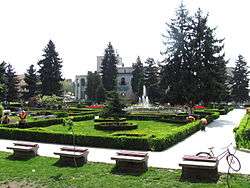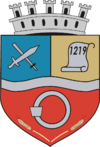Câmpia Turzii
| Câmpia Turzii | ||
|---|---|---|
| Municipality | ||
 | ||
| ||
 Location on Romania map | ||
| Coordinates: 46°32′55″N 23°52′48″E / 46.54861°N 23.88000°ECoordinates: 46°32′55″N 23°52′48″E / 46.54861°N 23.88000°E | ||
| Country |
| |
| County |
| |
| Status | Municipality | |
| Government | ||
| • Mayor | Radu Hanga (National Liberal Party) | |
| Area | ||
| • Total | 23.78 km2 (9.18 sq mi) | |
| Population (2011 census)[1] | ||
| • Total | 22,223 | |
| • Density | 930/km2 (2,400/sq mi) | |
| Time zone | EET (UTC+2) | |
| • Summer (DST) | EEST (UTC+3) | |
| Website | http://www.campiaturzii.ro/ | |
Câmpia Turzii (Romanian pronunciation: [kɨmˌpi.a ˈturzij]; German: Jerischmarkt; Hungarian: Aranyosgyéres) is a city in Cluj County, Romania, which was formed in 1925 by the union of two villages, Ghiriş (Aranyosgyéres) and Sâncrai (Szentkirály). It was declared a town in 1950 and a city in 1998.
The village of Sâncrai was mentioned in a 1219 document as "villa Sancti Regis" ("village of Holy King"),[2] while Ghiriş was first documented in 1292 as "Terra Gerusteleke" ("Gerusteleke", literally meaning "plot of Gerus" in Hungarian).
Michael the Brave was murdered by agents of Giorgio Basta at the current location of Câmpia Turzii on August 9, 1601.
Câmpia Turzii is the "city of adoption" of Toulouse.
Population
| Ethnic composition of Câmpia Turzii | |||||||||||||
| Year | Romanians | Hungarians | Romani | ||||||||||
|---|---|---|---|---|---|---|---|---|---|---|---|---|---|
| 1850 | 49% | 40% | 10% | ||||||||||
| 2002 census[3] | 87.03% | 8.16% | 4.66% | ||||||||||
The population has evolved as follows since 1784:
- 1784: Ghiriş: 565; Sâncrai: 472
- 1850: Ghiriş: 1,168; Sâncrai: 487
- 1910: Ghiriş: 1,815; Sâncrai: 704
- 1930 census: 4,124
- 1948 census: 6,310
- 1956 census: 11,518
- 1977 census: 22,418
- 2002 census: 26,823
- 2011 census: 22,223
Military activity
The city is home to the Romanian Air Force's RoAF 71st Air Base, and during the NATO Summit of 2008, the 323rd Air Expeditionary Wing of the United States Air Force. F-15s from RAF Lakenheath in the United Kingdom flew out during the summit to augment air defence forces for the event.
In April 2015, a U.S. Air Force group of A-10 Thunderbolt attack aircraft stationed in Germany arrived at the RoAF 71st Air Base to take part in exercises with the Romanian Air Force. [4]
References
| Wikimedia Commons has media related to Câmpia Turzii. |
- ↑ "Population at 20 October 2011" (in Romanian). INSSE. January 2014. Retrieved 20 August 2015.
- ↑ There were two Hungarian kings canonised by this time, Stephen I of Hungary and Ladislaus I of Hungary. Ladislaus was personally involved in several battles against Cuman invaders in this region.
- ↑ Centrul de Resurso. "Structura Etno-demografică a României". Retrieved 10 July 2012.
- ↑ http://theaviationist.com/2015/03/30/usaf-a-10s-romania/

